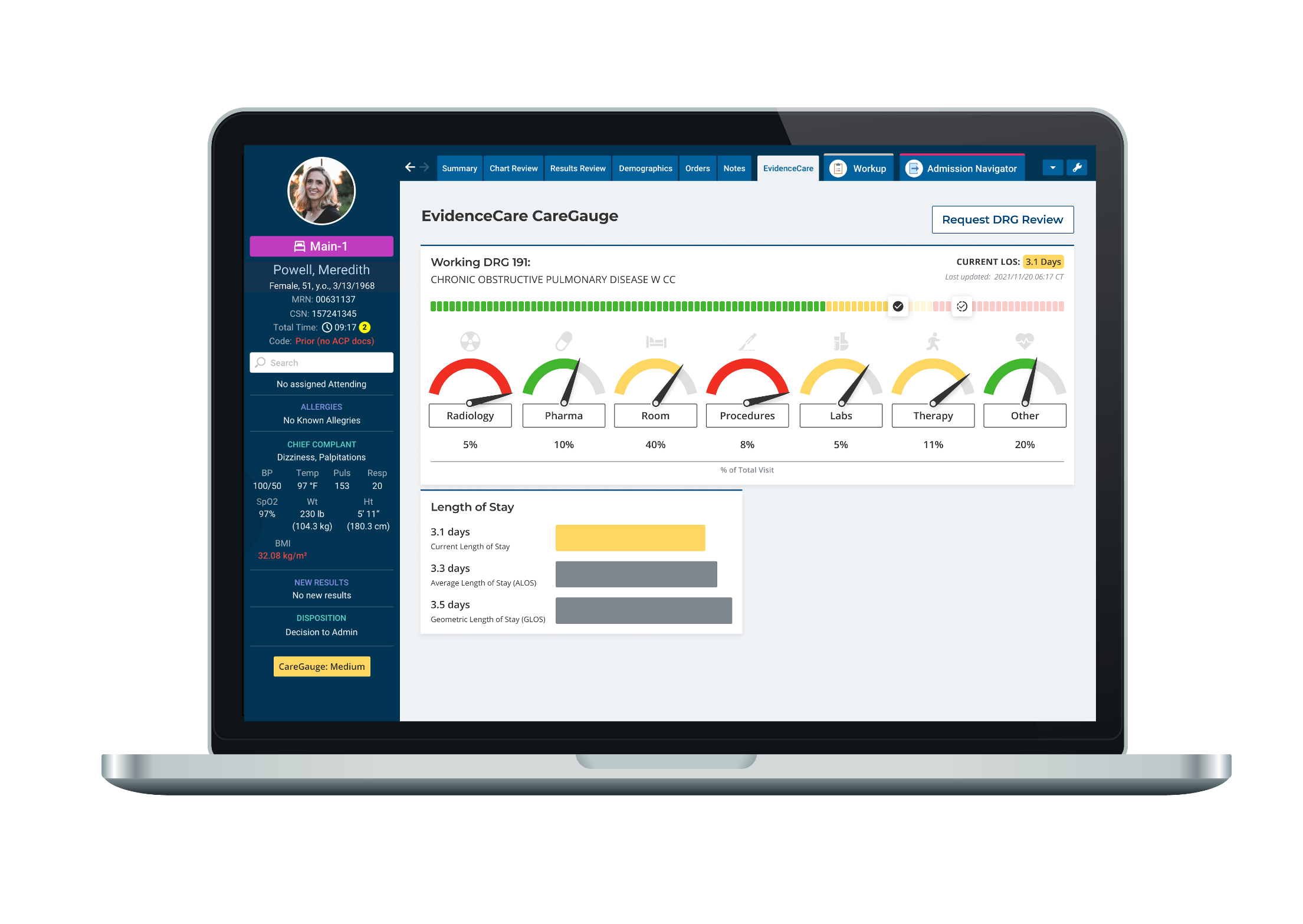Average Length of Stay
Patient length of stay remains among the most challenging issues facing many hospitals today. The average length of hospital stay indicates efficiency and effectiveness in health care and service delivery.
A long average length of stay can often indicate poor coordination of healthcare services and delayed decision-making, resulting in unnecessary hospital waits or early discharges. The longer a patient spends in the hospital, the higher the chances of developing healthcare-acquired infections (HAIs) and that’s just one of the reasons why the length of stay is important. Not to mention the costs associated with long length of stay.
Hospital Length of Stay Definition
Hospital length of stay (LOS) is a clinical metric that indicates the number of days an inpatient spends during a single admission. Hospitals use this metric to improve patient care and allocate hospital resources accordingly while reducing overall costs.
According to research conducted in the United States, there were approximately 36.4 million hospital stays in 2018. This research states that the average length of hospital stay in the United States is approximately 5.5 days.
But an AHA report from 2022 indicated a 19% increase in ALOS (average length of stay) from 2019 to 2022 and research from 2012 showed an average of 4.5 days. So there is clear indication that ALOS has grown in recent years since the COVID-19 pandemic.
It’s worth acknowledging that the average length of stay has significantly dropped over time at a macro level. According to the hospital length of stay dataset in the United States, hospitalization duration reduced from 20.5 days in the 1960s to approximately 5.4 days today. This remains one of the shortest lengths of stays globally, but you’ll be hard-pressed to find a US hospital leader who isn’t worried about reducing their current length of stay.
There is, of course, considerable variability in the average length of hospital stay by age and the average length of stay by diagnosis.
Recently, there have been innovations in reducing average hospital length of stay that have significantly helped hospitals improve throughput. Using length of stay software can help segment it according to treatment, condition, and demographics to visualize current data in real-time and determine when and where to make warranted changes to reduce length of stay.
However, length of stay is often a complex concept that multiple competing factors affect, such as:
-
- Presenting complaint
- Patient characteristics
- Treatment complexity
- Complications
- Admission and discharge planning
- Available hospital resources
These factors may extend the original target length of stay for individual hospitals. As such, a robust intervention and model that can accurately predict the patient’s length of stay for every visit could be an effective method to prevent extending the length of stay.
Inpatient days and length of stay are related but are different metrics; while inpatient days refer to the total number of days all patients spend in a hospital during a specific period, length of stay refers to the average number of days a patient stays in the hospital per admission.
Average Length of Stay for Acute Care Hospitals
While length of stay concepts may be challenging, acute care hospitals must understand them to make informed healthcare decisions. And although each patient is unique, various patients have many statistical similarities.
Hospital length of stay benchmarks allows hospital administrators to compare their length of care with patient-specific benchmarks, as well as local, regional, and national benchmarks based on experience.
Research conducted in 2017 found that acute care hospitals’ average length of stay was less than eight days. However, unnecessary and avoidable hospital delays, such as hospital-acquired complications, may prolong this stay.
The average range of hospital stay determines the average length of stay for acute care hospitals and labor and delivery with no complications. The inpatient days calculator is a useful tool that healthcare providers can use to monitor the number of days patients spend in the hospital for a given period.
Hospitals adopt their own methods to keep their length of stay below eight days through:
-
- Following the 5 R’s in inpatient placement: the right level of care, right nursing unit, right period, right bed, and right service.
- Discharging patients as soon as possible to avoid overcrowding and overwhelming the available resources.
- Using case management to streamline communication with patients and staff.
- Measuring and distributing the correct metrics.
- Reviewing patient census and managing elective admissions to minimize surges and balance with emergency admissions.
Why Is Length of Stay Important?
Length of hospital stay is a critical factor for effective and efficient planning and management of clinical resources. It provides an understanding of patient flow through hospital care units which is an important factor in assessing the operational functions of different healthcare systems.
Serving as a strong indicator of financial and medical efficiency, LOS benefits both patients and medical organizations.
A short stay greatly reduces the risks associated with hospital-acquired infections, cuts overall expenses, and frees up bed spaces to name just a few advantages.
Side effects of long hospital stays include but are not limited to:
-
- Psychological harm
- Infections
- Sleep deprivation
- Increased risk of physical harm
Some of the factors affecting length of stay in hospitals include:
-
- Doctor visit during hospitalization
- Months and time of admission
- History of the previous admission
- Type of admission
- Gender
- Type of Insurance
- Age
- Comorbidities
Reasons For Long Hospital Stays
Having looked at why the length of stay is important for hospitals, it’s evident that analyzing all factors involved and embracing recent trends in length of stay is crucial for health system leaders.
But to do that, understanding the reasons for long hospital stays and illnesses that require long hospital stays is necessary.
While these reasons are varied, they fall into the following categories:
-
- Manual processes. Using manual processes other than digital or automated systems remains one of the biggest obstacles to reducing the length of stay. Manual processes lead to delayed communication or miscommunication.
- Missing contact details for your post-acute partners. This is one of the easily overlooked parts of patient discharge. Do you have a system that automatically and instantly updates when your post-acute partners move, open, or close? Or track their points of contact and send them to your health system? If you don’t have such a system, it can cause delays and leave your patients admitted for longer.
- Staffing inefficiency. Have you tasked specific individuals to discharge patients? The patient discharge process shouldn’t take up time for individuals whose role is to provide patient care.
- Hospital-acquired infections. Patients that acquire new infections may be one of the main reasons to be in the hospital for days.
- Continuing care. Continued medical care such as surgery, chemotherapy, counseling, radiotherapy, etc.
- Chronic illnesses. Illnesses that require long hospital stays, such as cancer, congestive heart failure, chronic obstructive pulmonary disease, diabetes, chronic kidney injury, etc.
While some of these reasons and factors affecting the length of stay in the hospital can be mitigated, proper planning can lead to more desirable outcomes.
When patients receive fast and efficient hospital care and are discharged appropriately, they will likely refer their families and trust the hospital for future health care.
Average Length of Stay in Hospital Formula
How many days will a patient spend in a hospital for each new admission? Almost all healthcare insurance companies and hospitals would pay a fortune to know the answer to this question.
Today, hospitals have embraced technology to predict the discharge date for each inpatient. Moreover, many software have been used to determine the average length of stay and patient outcomes for effective planning and management.
The average length of stay in hospital in 2022 or 2023 is determined by dividing the total number of days spent by admitted patients in the specified period by the number of discharges or admissions (excluding outpatients/day cases).
The Average Length of Stay Formula
To obtain the average length of stay in hospital formula, follow these steps:
Average Length of stay calculation = (d1+d2+d3+d4+…….dn)/N.
(d represents patient days, and N represents the total number of patients.)
The total number of inpatient days include the sum of the days spent by all inpatients.
Here is an average length of stay example: d1=30, d2=28, d3=26, d4=35, d5=35, d6=25, and d7=25, then the total number of inpatient days is 204.
If the total number of patients(N) is 30, the average length of stay for this hospital is 204/30=6.8.
Reduce Length of Stay
A few factors that, if addressed precisely with the right predictive analytics and data, can reduce the length of stay, including:
-
- Proper patient placement. Using an algorithmic approach for patient placement reduces confusion and helps locate patients easily. Incorrectly placed patients end up in the wrong level of care, leading to slower recovery times or clinical complications.
- Forecast spike in patient numbers. Inpatient numbers are highly volatile in many hospitals. Spikes cause challenges in staffing, patient placement, and capacity management. Therefore, adopt a sophisticated length of stay reduction software to provide a more accurate forecast.
- Reduce admission delays. Admitting patients from outpatient or emergency departments is highly variable, time-sensitive, and often results in delays. Challenges in communication between the emergency departments, hospitalists, and utilization management staff can delay patient admission. Length of stay software, such as visibility tools, can help identify system delays and act accordingly.
- Smooth operating room flow. Patient flow from the operating to inpatient can cause a spike in patient numbers. Hence, optimizing elective surgical procedures with respect to recovery times helps avoid inpatient spikes or moving them away from the hospital altogether with an ambulatory strategy.
- Prioritize patients to be discharged. Identify and prioritize patients that are close to discharge to prevent discharge delays.
- Schedule some procedures for the outpatient department. Identify and transfer cases and procedures that can be handled at the outpatient.
- Use predictive discharge planning. Forecast avoidable discharge delays such as transport challenges, insurance documentation, and lack of space at referred specialized nursing facilities.
Reducing the length of hospital stay should be a priority for hospital administrators. Many hospitals face high costs due to readmission rates and unnecessary long stays.
Therefore, understanding how to reduce the length of stay in hospitals is critical in eliminating avoidable financial problems and the development of hospital-acquired infections.
EvidenceCare’s length of stay software, CareGauge, has proven to reduce length of stay by 5+ hours per patient by giving physicians real-time visibility into current and projected length of stay compared to patients with the same conditions based on peer-compared hospital data.
Schedule a demo of CareGauge today!










